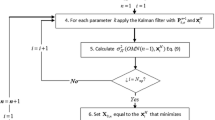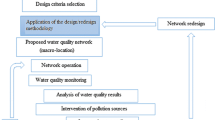Abstract
This paper presents a new methodology for the optimal design of space–time hydraulic head monitoring networks and its application to the Valle de Querétaro aquifer in Mexico. The selection of the space–time monitoring points is done using a static Kalman filter combined with a sequential optimization method. The Kalman filter requires as input a space–time covariance matrix, which is derived from a geostatistical analysis. A sequential optimization method that selects the space–time point that minimizes a function of the variance, in each step, is used. We demonstrate the methodology applying it to the redesign of the hydraulic head monitoring network of the Valle de Querétaro aquifer with the objective of selecting from a set of monitoring positions and times, those that minimize the spatiotemporal redundancy. The database for the geostatistical space–time analysis corresponds to information of 273 wells located within the aquifer for the period 1970–2007. A total of 1,435 hydraulic head data were used to construct the experimental space–time variogram. The results show that from the existing monitoring program that consists of 418 space–time monitoring points, only 178 are not redundant. The implied reduction of monitoring costs was possible because the proposed method is successful in propagating information in space and time.




















Similar content being viewed by others
References
Ahmadi, S. H., & Sedghamiz, A. (2007). Geostatistical analysis of spatial and temporal variations of groundwater level. Environmental Monitoring and Assessment, 129, 277–294.
Ahmadi, S. H., & Sedghamiz, A. (2008). Application and evaluation of kriging and cokriging methods on groundwater depth mapping. Environmental Monitoring and Assessment, 138, 357–368.
Andricevic, R. (1990). A real-time approach to management and monitoring of groundwater hydraulics. Water Resources Research, 26(11), 2747–2755.
Bravo, J. A. (2005). Diseño de una red de monitoreo para evaluar el comportamiento del acuífero del Valle de Querétaro durante la operación de la presa Extoraz. Tesis de maestría, UNAM, México.
Cameron, K., & Hunter, P. (2000). Optimization of LTM networks using GTS: statistical approaches to spatial and temporal redundancy. Tech. Rep., Air Force Center for environmental excellence. TX: Brooks AFB.
De Cesare, L., Myers, D. E., & Posa, D. (2001). Estimating and modeling space–time correlation structures. Statistics and Probability Letters, 51, 9–14.
De Cesare, L., Myers, D. E., & Posa, D. (2002). Fortran programs for space–time modeling. Computers & Geosciences, 28, 205–212.
De Iaco, S., Myers, D. E., & Posa, D. (2001). Space–time analysis using a general product–sum model. Statistics & Probability Letters, 52, 21–28.
De Iaco, S., Myers, D. E., & Posa, D. (2002). Space–time variograms and a functional form of total air pollution measurements. Computational Statistics & Data Analysis, 41, 311–328.
Delhomme, J. P. (1978). Kriging in the hydrosciences. Advances in Water Resources, 1(5), 251–266.
Deutsch, C. V., & Journel, A. G. (1997). GSLIB: geostatistical software library and user’s guide (2nd ed.). New York: Oxford University Press.
Ely, D. M., Hill, M. C., Tiedeman, C. R., & O’Brien, G. M. (2000). Evaluating observations in the context of predictions for the Death Valley regional groundwater system. In Proceedings of the 2000 Joint Conference on Water Resources Engineering and Water Resources Planning and Management, Minneapolis, MN, compact disk, American Society of Civil Engineers, Washington, DC.
Faisal, K. Z., Ahmed, S., Dewandel, B., & Maréchal, J. (2007). Optimizing a piezometric network in the estimation of the groundwater budget: a case study from a crystalline-rock watershed in southern India. Hydrogeology Journal, 15(6), 1131–1145.
Gambolati, G., & Volpi, G. (1979). Groundwater contour mapping in Venice by stochastic interpolators: 1. Theory. Water Resources Research, 15(2), 281–290.
Geofísica de Exploraciones Guysa (1991). Estudio geohidrológico integral del Valle de Querétaro y sus alrededores para el manejo automatizado de los recursos hidráulicos subterráneos, technical report, Comisión Estatal de Aguas, Querétaro, August 1990 – September 1991.
Herrera, G. S. (1998). Cost effective groundwater quality sampling network design. Ph. D. Dissertation, University of Vermont.
Herrera, G. S., & Pinder, G. F. (2005). Space–time optimization of groundwater quality sampling networks. Water Resources Research, 41(W12407), 15.
Herrera, G. S., Guarnaccia, J., Pinder, G. F., & Simuta, R. (2001). Design of efficient space–time groundwater quality sampling networks. In Proceedings of the 2001 International Symposium on Environmental Hydraulics, ISEH.
Herrera, G. S., Júnez-Ferreira, H. E., González, L., & Cardona, A. (2004). Diseño de una red de monitoreo de la calidad del agua para el acuífero Irapuato-Valle, Guanajuato. Memorias del XVIII Congreso Nacional de Hidráulica, AMH, SLP, México.
Hill, M. C., Ely, M. D., Tiedeman, C. R., D’Agnese, F. A., Faunt, C. C., & O’Brien, B. A. (2000). Preliminary evaluation of the importance of existing hydraulic head observation locations to advective-transport prediction, Death Valley regional flow system, California and Nevada. U.S. Geological Survey Water-Resources Investigations Report 00-4282, http://pubs.usgs.gov/wri/wri004282/book/wri004282.pdf. Accessed 3 September 2009.
Jazwinski, A. H. (1970). Stochastic processes and filtering theory. London: Academic Press.
Journel, A. G., & Huijbregts, C. J. (1978). Mining geostatistics. London: Academic.
Júnez-Ferreira, H. E. (2005). Diseño de una red de monitoreo de la calidad del agua para el acuífero Irapuato-Valle, Guanajuato. Tesis de Maestría, UNAM, México. Online access http://132.248.9.195/ptd2012/anteriores/0339152/Index.html
Júnez-Ferreira, H. E. (2011). Optimización de redes de monitoreo de la carga hidráulica utilizando métodos geoestadísticos espacio-temporales. Tesis de Doctorado. UNAM, México. Online access: http://132.248.9.195/ptd2012/mayo/0679742/Index.html
Kemal, S. G., & Guney, I. (2007). Spatial analyses of groundwater levels using universal kriging. Journal of Earth System Science, 116(1), 49–55.
Kyriakidis, P. C., & Journel, A. G. (1999). Geostatistical space–time models: a review. Mathematical Geology, 31(6), 651–684.
Kumar, S., Sondhi, S. K., & Phogat, V. (2005). Network design for groundwater level monitoring in Upper Bari Doab canal tract, Punjab, India. Irrigation and Drainage, 54, 431–442.
Lin, Y., & Rouhani, S. (2001). Multiple-point variance analysis for optimal adjustment of a monitoring network. Environmental Monitoring and Assessment, 69, 239–266.
Loaiciga, H. A. (1989). An optimization approach for groundwater quality monitoring network design. Water Resources Research, 25(8), 1771–1782.
Loaiciga, H. A., Charbeneau, R. J., Everett, L. G., Fogg, G. E., & Hobbs, B. F. (1992). Review of groundwater quality monitoring network design. Journal of Hydraulic Engineering, 118(1), 11–32.
Mendoza, E. Y. (2008). Análisis de Alternativas para la Estimación de la Carga Hidráulica Utilizando Métodos Geoestadísticos en Espacio y Espacio-Tiempo. Tesis de doctorado, UNAM, México.
Mendoza, E. Y., & Herrera, G. S. (2007). Estimación multivariada espacio-tiempo de la carga hidráulica en el Valle de Querétaro-Obrajuelo. Ingeniería hidráulica en México, 22(1), 63–80.
Mogheir, Y., Singh, V. P., & de Lima, J. L. M. P. (2006). Spatial assessment and redesign of a groundwater quality monitoring network using entropy theory, Gaza Strip, Palestine. Hydrogeology Journal, 14, 700–712.
Myers, D. E., & Journel, A. (1990). Variograms with zonal anisotropies and noninvertible kriging sytems. Mathematical Geology, 22(7), 779–785.
Nunes, L. M., Cunha, M. C., & Ribeiro, L. (2004a). Groundwater monitoring network optimization with redundancy reduction. Journal of Water Resources Planning and Management, 1(33), 33–43.
Nunes, L. M., Cunha, M. C., & Ribeiro, L. (2004b). Optimal space–time coverage and exploration costs in groundwater monitoring networks. Environmental Monitoring and Assessment, 93, 103–124.
Rouhani, S. (1985). Variance reduction analysis. Water Resources Research, 21(6), 837–846.
Rouhani, S., & Hall, T. (1988). Geostatistical schemes for groundwater sampling. Journal of Hydrology, 103(1), 85–102.
Rouhani, S., & Hall, T. (1989). Space–time kriging of groundwater data. In: M. Armstrong (Ed.) Geostatistics, Vol. 2. Dordrecht: Kluwer Academic.
Rouhani, S., & Myers, D. E. (1990). Problems in space–time kriging of geohydrological data. Mathematical Geology, 22(5), 611–623.
Samper, F. J., & Carrera, J. (1990). Geoestadística, aplicaciones a la hidrogeología subterránea. Barcelona: Centro Internacional de Métodos Numéricos en Ingeniería, UPC.
Storck, P., Valocchi, A. J. & Eheart, J. W. (1995). Optimal location of monitoring wells for detection of groundwater contamination in three-dimensional heterogeneous aquifers. Models for Assessing and Monitoring Groundwater Quality (Proceedings of a Boulder Symposium. IAHS), 227, 39–47.
Ta’any, R. A., & Tahboub, A. B. (2009). Geostatistical analysis of spatiotemporal variability of groundwater level fluctuations in Amman-Zarqa basin, Jordan: a case study. Environmental Geology, 57, 525–535.
Van Geer, F. C., Te Stroet, C. B. M., & Yangxiao, Z. (1991). Using Kalman filtering to improve and quantify the uncertainty of numerical groundwater simulations: 1. The role of system noise and its calibration. Water Resources Research, 27(8), 1987–1994.
Volpi, G., Gambolati, G., Carbognin, L., & Mozzi, G. (1979). Groundwater contour mapping in Venice by stochastic interpolators: 2. Results. Water Resources Research, 15(2), 291–297.
Webster, R., & Oliver, M. (2007). Geostatistics for environmental scientists. UK: Wiley.
Wu, Y. (2003). Optimal design of a groundwater monitoring network in Daqing, China. Environmental Geology, 45, 527–535.
Yangxiao, Z., Te Stroet, C. B., & Van Geer, F. (1991). Using Kalman filtering to improve and quantify the uncertainty of numerical groundwater simulations: 2. Application to monitoring network design. Water Resources Research, 27(8), 1995–2006.
Zhang, Y., Pinder, G. F., & Herrera, G. S. (2005). Least cost design of groundwater quality monitoring networks. Water Resources Research, 41(W08412), 13.
Acknowledgments
H. E. Júnez-Ferreira greatly appreciates the support of the Consejo Nacional de Ciencia y Tecnología (CONACYT) for a scholarship grant from February 2009 to August 2010. We would also like to acknowledge the reviewers for their comments and suggestions which helped us to improve this paper.
Author information
Authors and Affiliations
Corresponding author
Rights and permissions
About this article
Cite this article
Júnez-Ferreira, H.E., Herrera, G.S. A geostatistical methodology for the optimal design of space–time hydraulic head monitoring networks and its application to the Valle de Querétaro aquifer. Environ Monit Assess 185, 3527–3549 (2013). https://doi.org/10.1007/s10661-012-2808-5
Received:
Accepted:
Published:
Issue Date:
DOI: https://doi.org/10.1007/s10661-012-2808-5




